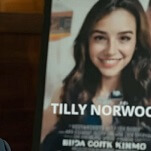Ribald Retro Case File #146: Down With Love
To be a film critic in this day and age is to be intimately in touch with your own powerlessness. But I don’t think I’m telling tales out of school when I say that The A.V. Club rules the Chicago film-critic community through fear, intimidation, and constant beatings with rusty chains. We swagger into the screening room four deep, our giant pompadours gleaming with Brylcreem. We menacingly pick our teeth with switchblades, the handles of our Saturday-night specials peeking ominously from our waistbands.
When we get behind a movie like Down With Love, today’s entry in My Year Of Flops, our fellow critics know to fall in line or risk ending up on the receiving end of one of Scott Tobias’ vicious haymakers. In attitude and disposition, we’re more like a street gang in a ’50s exploitation movie than a collection of cultural commentators. We’re like the T-Birds and Pink Ladies from Grease, only with a greater appreciation for the films of Yasujiro Ozu and Kenji Mizoguchi. The folks who run the screening room would ban us en masse and end our decade-long reign of terror, except that they fear for the lives of their families.
So it’s not surprising that Chicago critics by and large embraced Down With Love even as their less enlightened/threatened peers gave it mixed reviews: It got two thumbs up from Ebert & Roeper and was No. 2 on the top 10 list of Chicago Reader critic Jonathan Rosenbaum. As a loving, meticulous homage to the Doris Day/Rock Hudson sex comedies of the late ’50s and early ’60s, Down With Love was custom-designed for pop-culture geeks, which makes the critical shrug that accompanied its release even more surprising. Its commercial failure is a little more understandable: Apparently the general public in 2003 wasn’t salivating for a cheeky period pastiche that gently lampoons Camelot-era battle-of-the-sexes comedies.
Then again, I have a special relationship with the films that inspired Down With Love. While other, less perverse parents rented Chevy Chase vehicles for their children, my dad made a special point of renting me only musicals and Rock Hudson/Doris Day movies, as part of his surprisingly unsuccessful plot to make me gay.
When I was growing up, Rock Hudson represented strapping, lantern-jawed, super-masculine heterosexuality. My father also inexplicably felt the need to inform my 10-year-old self that Randolph Scott, who I of course knew from his performance in the 1935 Fred Astaire/Ginger Rogers musical Roberta, the film that introduced “Smoke Gets In Your Eyes,” was gay as well, and lived for a time with his boyfriend Cary Grant. So I assumed from that point forward that all macho actors were closeted homosexuals. Why did my father tell me these things? Damned if I know. I do not have a normal dad. Nor did I have a normal childhood.
So when I watched Down With Love, I was filled with warm memories of childhood afternoons spent watching Rock Hudson and Doris Day romantic comedies. Mark Rappaport’s documentary Rock Hudson’s Home Movies does a fascinating, though academic job, unpacking the rampant double entendres and myriad winking references to Hudson’s homosexuality that litter his films. Re-watching the 1961 Hudson/Day vehicle Lover Come Back for a recent Inventory, I was struck by its unapologetic, unrelenting raunchiness. Operating solely through innuendo and intimation, it manages to be far filthier than any American Pie or There’s Something About Mary knockoff.
Bring It On director Peyton Reed pushes the all-consuming smuttiness of Hudson/Day movies to comic extremes in his fizzy retro concoction Down With Love. In the film’s most inventive sequence, Reed strategically moves around the center-line of a split screen until leads Ewan McGregor and Renée Zellweger appear to be pantomiming energetic sex acts while conversing on the phone. Then they hang up and enjoy an ecstatic cigarette.
Down With Love captures that glorious Camelot-era utopian American Triumphalism that decreed “Society doesn’t have to evolve any further, because it has been perfected.” We had a movie-star-handsome president, a glamorous fashion plate for a first lady, big shiny buildings stretching to the heavens, cars as big and sleek as rocket ships, and a thriving economy. Plus holy shit, we were going to the fucking moon. Everyone seemed to work in advertising and publishing, no lunch was complete without a martini or three, and every office boasted a crystal decanter of scotch to be used as often as possible. The future was now: That glorious tomorrow was today.
Everything was larger than life, literally. In the film, when first-time author Zellweger arrives in New York to promote her first book, she’s given a furnished apartment roughly the size of Buckingham Palace. Zellweger has written a manifesto titled Down With Love, which encourages women to have sex “à la carte,” without commitment or emotional attachment. In the film’s comic-book 1962, that’s a revolutionary conceit. After Zellweger’s book gets plugged on The Ed Sullivan Show, it becomes an international sensation over the course of a single montage sequence.







































